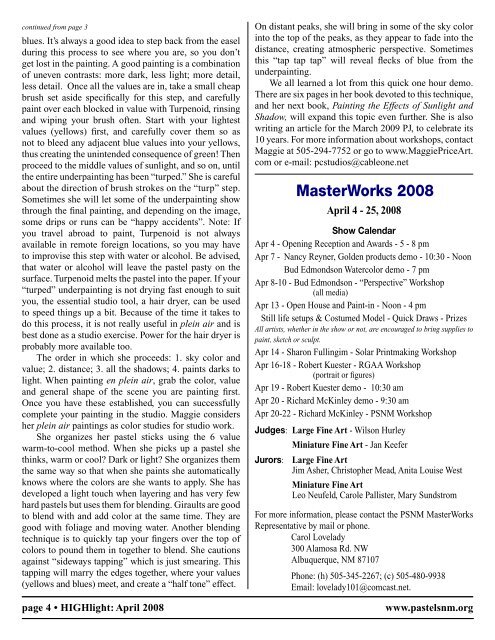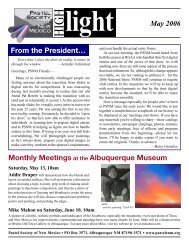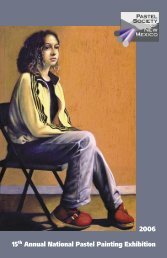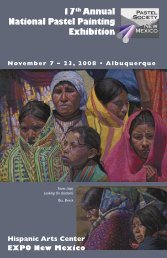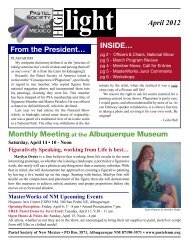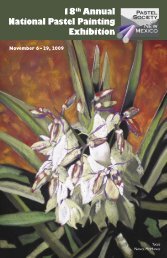April 2008 Highlight - Pastel Society of New Mexico
April 2008 Highlight - Pastel Society of New Mexico
April 2008 Highlight - Pastel Society of New Mexico
Create successful ePaper yourself
Turn your PDF publications into a flip-book with our unique Google optimized e-Paper software.
continued from page 3<br />
blues. It’s always a good idea to step back from the easel<br />
during this process to see where you are, so you don’t<br />
get lost in the painting. A good painting is a combination<br />
<strong>of</strong> uneven contrasts: more dark, less light; more detail,<br />
less detail. Once all the values are in, take a small cheap<br />
brush set aside specifically for this step, and carefully<br />
paint over each blocked in value with Turpenoid, rinsing<br />
and wiping your brush <strong>of</strong>ten. Start with your lightest<br />
values (yellows) first, and carefully cover them so as<br />
not to bleed any adjacent blue values into your yellows,<br />
thus creating the unintended consequence <strong>of</strong> green! Then<br />
proceed to the middle values <strong>of</strong> sunlight, and so on, until<br />
the entire underpainting has been “turped.” She is careful<br />
about the direction <strong>of</strong> brush strokes on the “turp” step.<br />
Sometimes she will let some <strong>of</strong> the underpainting show<br />
through the final painting, and depending on the image,<br />
some drips or runs can be “happy accidents”. Note: If<br />
you travel abroad to paint, Turpenoid is not always<br />
available in remote foreign locations, so you may have<br />
to improvise this step with water or alcohol. Be advised,<br />
that water or alcohol will leave the pastel pasty on the<br />
surface. Turpenoid melts the pastel into the paper. If your<br />
“turped” underpainting is not drying fast enough to suit<br />
you, the essential studio tool, a hair dryer, can be used<br />
to speed things up a bit. Because <strong>of</strong> the time it takes to<br />
do this process, it is not really useful in plein air and is<br />
best done as a studio exercise. Power for the hair dryer is<br />
probably more available too.<br />
The order in which she proceeds: 1. sky color and<br />
value; 2. distance; 3. all the shadows; 4. paints darks to<br />
light. When painting en plein air, grab the color, value<br />
and general shape <strong>of</strong> the scene you are painting first.<br />
Once you have these established, you can successfully<br />
complete your painting in the studio. Maggie considers<br />
her plein air paintings as color studies for studio work.<br />
She organizes her pastel sticks using the 6 value<br />
warm-to-cool method. When she picks up a pastel she<br />
thinks, warm or cool Dark or light She organizes them<br />
the same way so that when she paints she automatically<br />
knows where the colors are she wants to apply. She has<br />
developed a light touch when layering and has very few<br />
hard pastels but uses them for blending. Giraults are good<br />
to blend with and add color at the same time. They are<br />
good with foliage and moving water. Another blending<br />
technique is to quickly tap your fingers over the top <strong>of</strong><br />
colors to pound them in together to blend. She cautions<br />
against “sideways tapping” which is just smearing. This<br />
tapping will marry the edges together, where your values<br />
(yellows and blues) meet, and create a “half tone” effect.<br />
page 4 • HIGHlight: <strong>April</strong> <strong>2008</strong><br />
On distant peaks, she will bring in some <strong>of</strong> the sky color<br />
into the top <strong>of</strong> the peaks, as they appear to fade into the<br />
distance, creating atmospheric perspective. Sometimes<br />
this “tap tap tap” will reveal flecks <strong>of</strong> blue from the<br />
underpainting.<br />
We all learned a lot from this quick one hour demo.<br />
There are six pages in her book devoted to this technique,<br />
and her next book, Painting the Effects <strong>of</strong> Sunlight and<br />
Shadow, will expand this topic even further. She is also<br />
writing an article for the March 2009 PJ, to celebrate its<br />
10 years. For more information about workshops, contact<br />
Maggie at 505-294-7752 or go to www.MaggiePriceArt.<br />
com or e-mail: pcstudios@cableone.net<br />
MasterWorks <strong>2008</strong><br />
<strong>April</strong> 4 - 25, <strong>2008</strong><br />
Show Calendar<br />
Apr 4 - Opening Reception and Awards - 5 - 8 pm<br />
Apr 7 - Nancy Reyner, Golden products demo - 10:30 - Noon<br />
Bud Edmondson Watercolor demo - 7 pm<br />
Apr 8-10 - Bud Edmondson - “Perspective” Workshop<br />
(all media)<br />
Apr 13 - Open House and Paint-in - Noon - 4 pm<br />
Still life setups & Costumed Model - Quick Draws - Prizes<br />
All artists, whether in the show or not, are encouraged to bring supplies to<br />
paint, sketch or sculpt.<br />
Apr 14 - Sharon Fullingim - Solar Printmaking Workshop<br />
Apr 16-18 - Robert Kuester - RGAA Workshop<br />
(portrait or figures)<br />
Apr 19 - Robert Kuester demo - 10:30 am<br />
Apr 20 - Richard McKinley demo - 9:30 am<br />
Apr 20-22 - Richard McKinley - PSNM Workshop<br />
Judges: Large Fine Art - Wilson Hurley<br />
Jurors:<br />
Miniature Fine Art - Jan Keefer<br />
Large Fine Art<br />
Jim Asher, Christopher Mead, Anita Louise West<br />
Miniature Fine Art<br />
Leo Neufeld, Carole Pallister, Mary Sundstrom<br />
For more information, please contact the PSNM MasterWorks<br />
Representative by mail or phone.<br />
Carol Lovelady<br />
300 Alamosa Rd. NW<br />
Albuquerque, NM 87107<br />
Phone: (h) 505-345-2267; (c) 505-480-9938<br />
Email: lovelady101@comcast.net.<br />
www.pastelsnm.org


